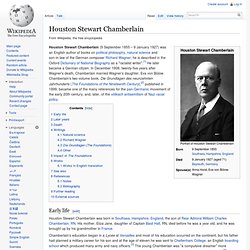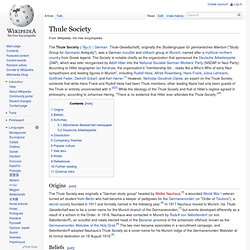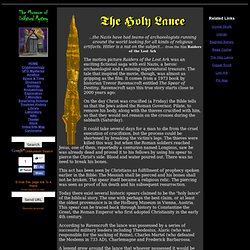

Friedrich Nietzsche. Friedrich Wilhelm Nietzsche (/ˈniːtʃə/[1] or /ˈniːtʃi/;[2] German: [ˈfʁiːdʁɪç ˈvɪlhɛlm ˈniːt͡sʃə]; 15 October 1844 – 25 August 1900) was a German philosopher, cultural critic, poet, composer and Latin and Greek scholar.

He wrote several critical texts on religion, morality, contemporary culture, philosophy and science, displaying a fondness for metaphor[3] and irony. Nietzsche's key ideas include perspectivism, the will to power, the death of God, the Übermensch and eternal recurrence. One of the key tenets of his philosophy is "life-affirmation", which embraces the realities of the world in which we live over the idea of a world beyond. Nietzsche began his career as a classical philologist—a scholar of Greek and Roman textual criticism—before turning to philosophy.
Richard Wagner. Houston Stewart Chamberlain. Houston Stewart Chamberlain (9 September 1855 – 9 January 1927) was an English author of books on political philosophy, natural science and son-in-law of the German composer Richard Wagner; he is described in the Oxford Dictionary of National Biography as a "racialist writer".[1] He later became a German citizen.

In December 1908, twenty-five years after Wagner's death, Chamberlain married Wagner's daughter, Eva von Bülow. Chamberlain's two-volume book, Die Grundlagen des neunzehnten Jahrhunderts (The Foundations of the Nineteenth Century),[2] published in 1899, became one of the many references for the pan-Germanic movement of the early 20th century, and, later, of the völkisch antisemitism of Nazi racial policy. Early life[edit] He then traveled to various spas around Europe, accompanied by a Prussian tutor, Herr Otto Kuntze, who taught him German and interested him in German culture and history. Later years[edit] In 1889 he moved to Austria. The Foundations of the Nineteenth Century.
The Foundations of the Nineteenth Century (Die Grundlagen des neunzehnten Jahrhunderts, 1899) was the best-selling work by Houston Stewart Chamberlain.

In it he advances various racist and especially völkisch antisemitic theories on how he saw the Aryan race as superior to others, and the Teutonic peoples as a positive force in European civilization and the Jews as a negative one. Chamberlain was an English germanophile who adopted German citizenship and wrote most of his works in German (on numerous subjects, from biographies to biology). Karl Maria Wiligut. Karl Maria Wiligut (alias Weisthor, Jarl Widar, Lobesam) (December 10, 1866,[1] Vienna, Austrian Empire – January 3, 1946, Arolsen, Germany[2]) was an Austrian Occultist and SS-Brigadeführer.

Early life[edit] Wiligut was baptised a Roman Catholic[1] in Vienna. At the age of 14, he joined the Kadettenschule there.[1] Aged 17, he was conscripted to the k.u.k. infantry regiment of Milan I king of Serbia. On 17 December 1883 he was appointed to infantry, four days later he became a Gefreiter (private). Swastika. The swastika (also known as the gammadion cross, cross cramponnée, or manji) is a symbol that generally takes the form of an equilateral cross, with its four legs bent at 90 degrees (as a Chinese character: 卐 or 卍).[1][2] It was throughout the world considered a very important symbol.

It is today considered to be a very sacred and auspicious symbol in Hinduism, Buddhism and Jainism.[3] It has been used as a decorative element in various cultures since at least the Neolithic, and is found on a man's tunic depicted in a Roman mosaic at the Villa Romana del Casale in Sicily. It is known most widely as an important symbol long used in Indian religions, denoting "auspiciousness. " It was adopted as such in pre-World War I-Europe and later, and most notably, by the Nazi Party and Nazi Germany prior to World War II . The word swastika derives from the Sanskrit svastika "lucky or auspicious object". Names[edit] Other names for the symbol include: Guido von List. Thule Society. The Thule Society (/ˈθjuːliː/; German: Thule-Gesellschaft), originally the Studiengruppe für germanisches Altertum ("Study Group for Germanic Antiquity"), was a German occultist and völkisch group in Munich, named after a mythical northern country from Greek legend.

The Society is notable chiefly as the organization that sponsored the Deutsche Arbeiterpartei (DAP), which was later reorganized by Adolf Hitler into the National Socialist German Workers' Party (NSDAP or Nazi Party). Origins[edit] Beliefs[edit] A primary focus of Thule-Gesellschaft was a claim concerning the origins of the Aryan race. In 1917 people who wanted to join the "Germanic Order", out of which the Thule Society developed in 1918, had to sign a special "blood declaration of faith" concerning the lineage: "The signer hereby swears to the best of his knowledge and belief that no Jewish or coloured blood flows in either his or in his wife's veins, and that among their ancestors are no members of the coloured races.
Dietrich Eckart. Dietrich Eckart. The Holy Lance. ...the Nazis have had teams of archaeologists running around the world looking for all kinds of religious artifacts.
